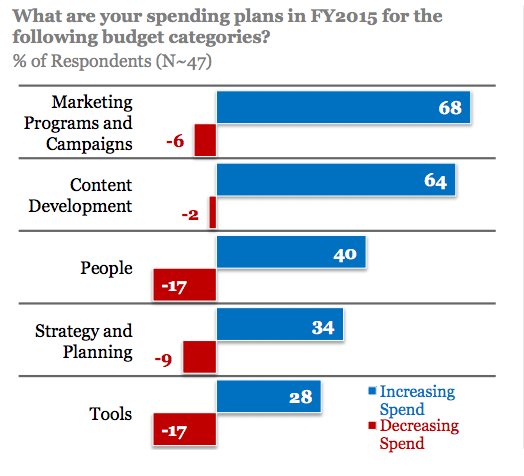When it comes to marketing budgets, I often get asked two questions. The first question is usually something like: “How much are other B2B marketers spending on content?”
Now, I have a better answer. 64% of B2B marketing leaders are planning to increase their spending on content development this year, representing the second largest category of increased spending, according to a study by ITSMA. Content is clearly a pressing need within B2B.

But this chart doesn’t the answer the second question I get about budgets. That one typically goes like this:
“How much should I spend on content?”
In these cases, I respond with another question: “How much do you want your marketing efforts to work?”
The reason why content development is so important is that all of marketing runs on content. SEO, inbound, PR, marketing automation, sales enablement—with the majority of the buyer’s journey taking place digitally, content is the catalyst for every stage of that journey. So content is critical to the success of all marketing functions, channels, and tools.
How marketers go about budgeting their investment in content is often short-sighted. The main areas of focus are on the costs (and only sometimes the returns) associated with hiring freelancers, aggregating articles, updating websites, outsourcing videos, etc. The first thing any marketer serious about content should consider is what tools and/or services they need to update their process to support the content fueling their channels, goals, and moving buyers forward.
Think about it. Marketing, particularly in B2B, is spending millions of dollars on technology. Most of this technology is designed to support one stage or facet of the buyer’s journey. In almost every case, those investments are dependent on content.
Yet, most marketing organizations fail to put in a modernized process for creating, distributing, and optimizing that content collaboratively and cross-functionally. It’s like trying to build a fancy house, complete with the latest gadgets, and forgetting the foundation.
“[Content] and marketing automation work hand-in-hand,” says Tiffany Coyle, a digital marketing manager of USGBC says.
“We can’t do marketing automation without thinking about content marketing.”
The first question in any discussion around budgeting for content—or marketing—should be: “Do we have the process and tools to successfully produce, publish, and maximize the content we need to support our efforts and move buyers through our pipeline?” I would argue the honest answer at most organizations is “no.”
And the next dollar you spend on content should move you toward “yes.”
